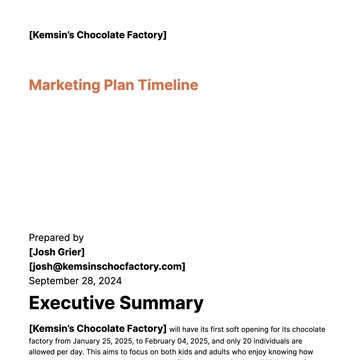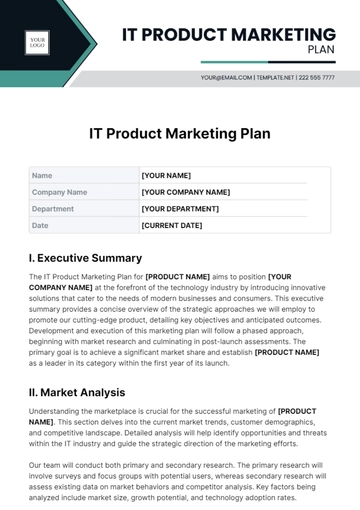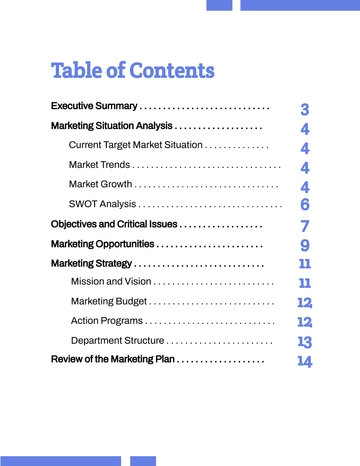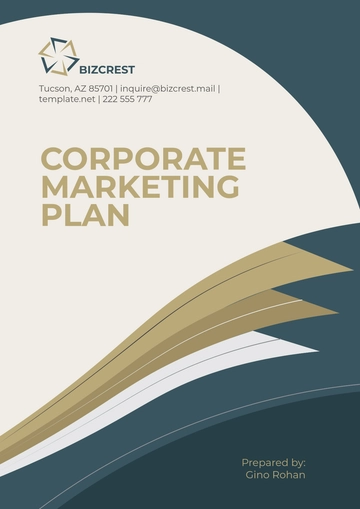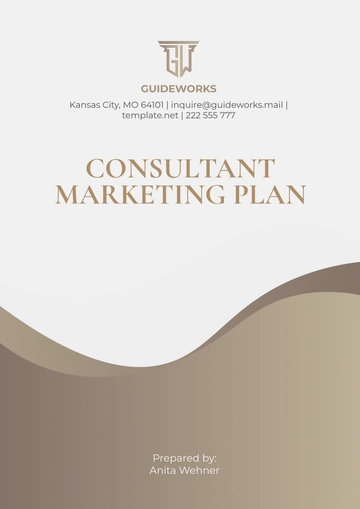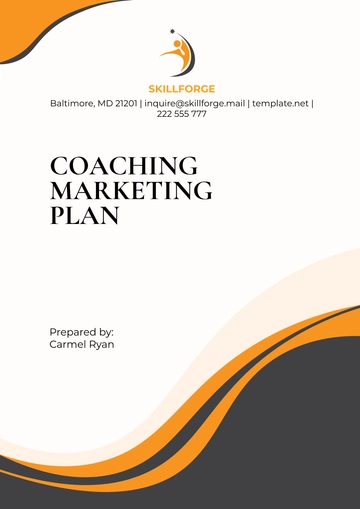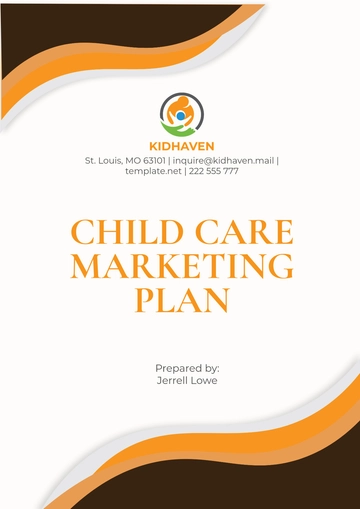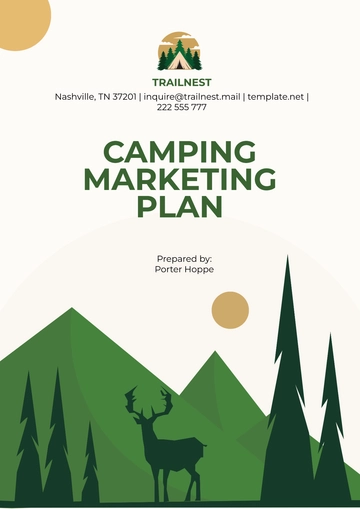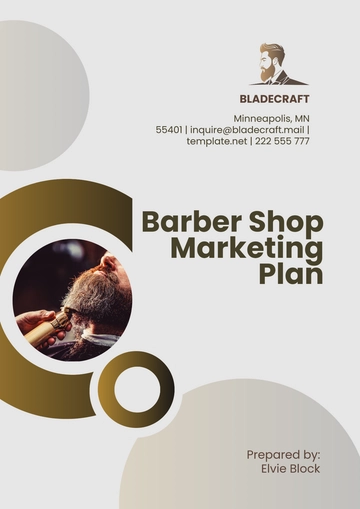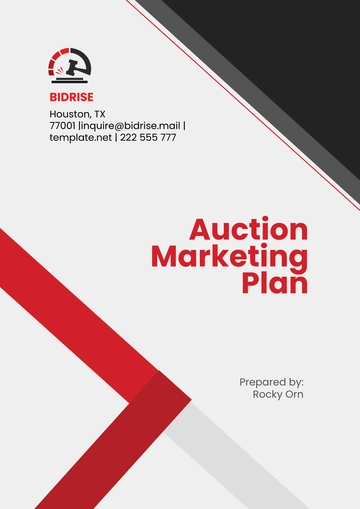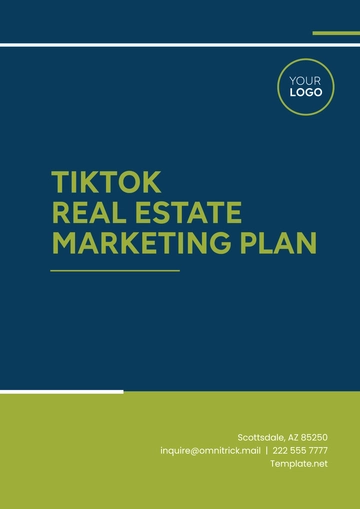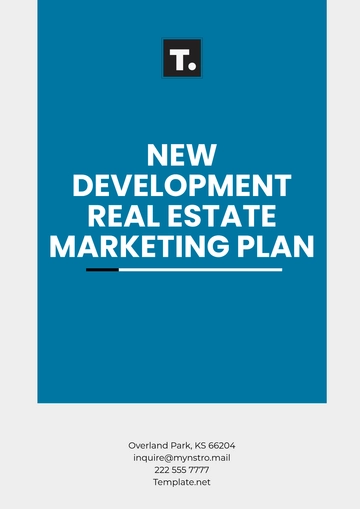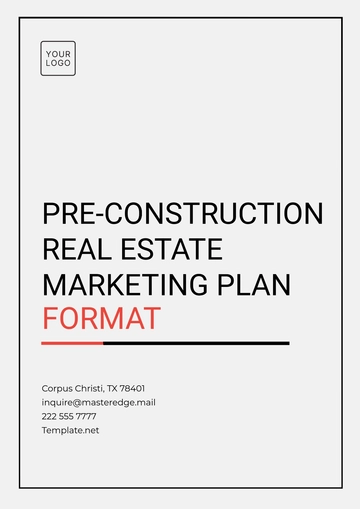Free Real Estate Annual Marketing Plan
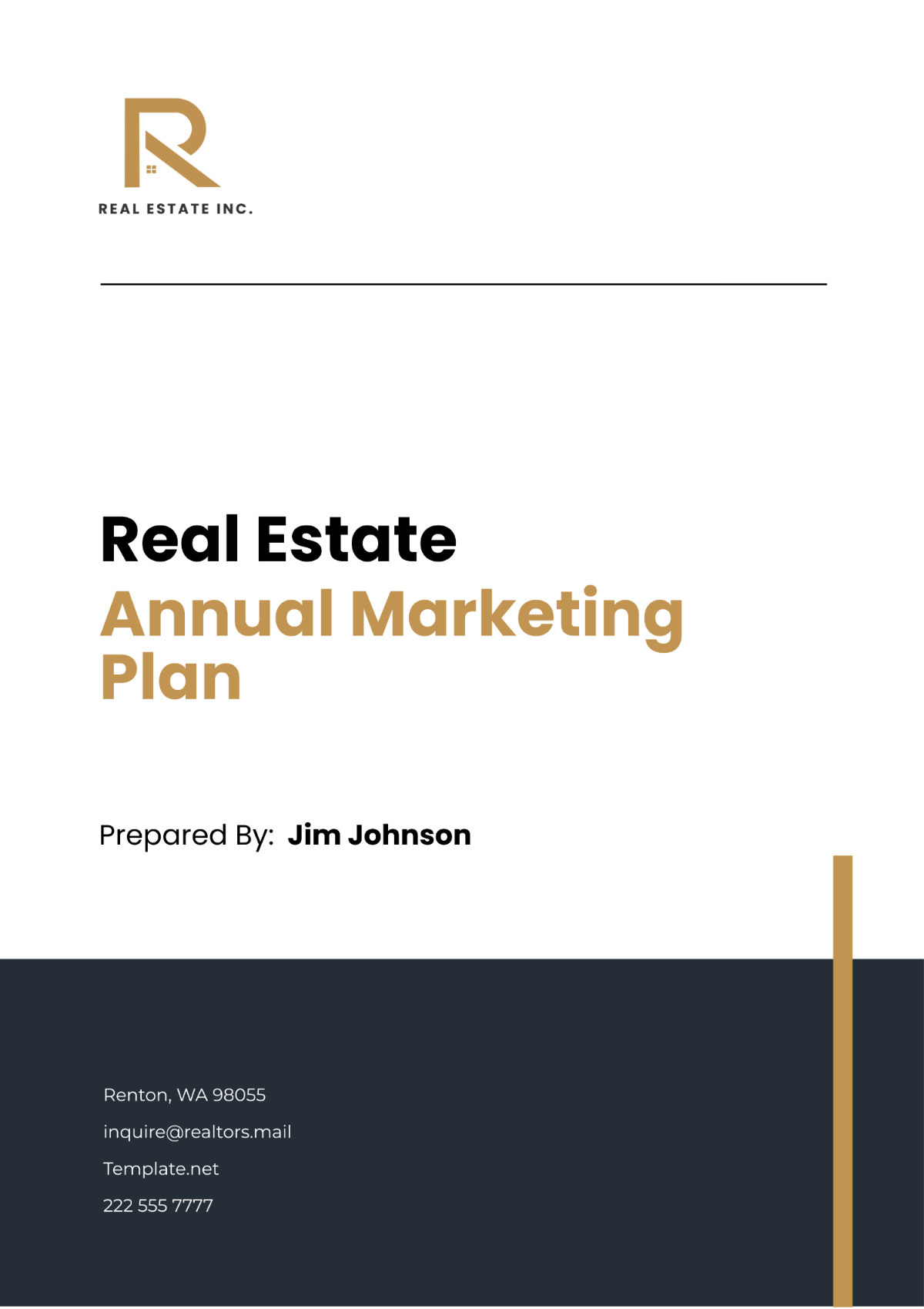
I. Executive Summary
[Your Company Name] is positioned to be a leading real estate firm in the [City/Region] area, with a focus on residential properties. Our annual marketing plan outlines a comprehensive strategy designed to enhance our brand visibility, engage with potential clients, and ultimately drive sales and revenue growth. The key objectives for the year include increasing property listings by 20%, boosting sales by 15%, and expanding our digital presence to reach a broader audience. This plan leverages both digital and traditional marketing channels, tailored to our target market's preferences and behaviors.
II. Market Analysis
Current Real Estate Market Conditions
The real estate market in [City/Region] has shown steady growth over the past year, with a 5% increase in home sales and a 7% rise in average property values. Despite economic uncertainties, the demand for housing remains strong, fueled by low interest rates and a growing population.
Local Market Trends and Predictions
Trend 1: There's a growing demand for eco-friendly and smart homes among younger buyers.
Trend 2: Remote work policies have increased the desire for properties with home offices.
Prediction: We anticipate a 10% increase in market demand for suburban homes with extra space.
SWOT Analysis
Strengths | Weaknesses | Opportunities | Threats |
|---|---|---|---|
Strong brand recognition | Limited market presence outside [City/Region] | Expanding into new markets | Economic downturns |
Experienced sales team | Dependence on traditional marketing channels | Increasing demand for virtual property showings | Rising competition |
Competitive Analysis
It is evident that [Your Company Name] distinctly separates itself from the competition with our exceptional level of personalized service designed specifically for each client. Further bolstering this advantage is our in-depth understanding and expertise in the market and the way in which we successfully leverage advanced technology to facilitate virtual property showings. Despite these accomplishments, to successfully increase the proportion of the market that we cater to, there is a pressing need for us to significantly augment our efforts in digital marketing. Moreover, we also need to broaden our scope by venturing into emerging markets within the region which are largely untapped.
III. Target Market
Primary Target Market | Secondary Target Market |
|---|---|
|
|
IV. Marketing Goals and Objectives
Goal | Objective |
|---|---|
Goal 1: Increase property listings by 20% through targeted campaigns to potential sellers in [City/Region]. | Objective: Launch a "Why Now is the Right Time to Sell" educational campaign by Q2. |
Goal 2: Boost overall sales by 15% by enhancing our online presence and streamlining the buying process. | Objective: Develop and implement a comprehensive digital marketing strategy by Q1. |
Goal 3: Improve client satisfaction scores by 10% by providing exceptional service and follow-up. | Objective: Implement a new customer relationship management (CRM) system by Q3. |
V. Marketing Strategies and Channels
Digital Marketing
Website Optimization and SEO:
Objective: Increase website traffic by 30%.
Strategy: Update website with SEO-friendly content, focusing on keywords related to [City/Region] real estate, and improve site speed and mobile responsiveness.
Content Marketing:
Objective: Establish [Your Company Name] as a thought leader in the real estate industry.
Strategy: Publish bi-weekly blog posts on market trends, buying/selling tips, and community highlights. Offer downloadable guides for buyers and sellers to capture leads.
Social Media Marketing:
Objective: Increase social media engagement by 50%.
Strategy: Utilize platforms like Instagram and Facebook to showcase properties, share client testimonials, and community events. Run targeted ad campaigns to reach potential buyers and sellers.
Email Marketing:
Objective: Improve email open rates by 20%.
Strategy: Segment email lists to send personalized property suggestions, market updates, and exclusive offers. Implement automation for follow-ups and client anniversaries.
Paid Advertising:
Objective: Generate 500 new leads through PPC and social media ads.
Strategy: Create targeted ad campaigns focusing on unique property features, virtual tours, and community events, utilizing Google Ads and Facebook Ads to reach potential buyers actively searching for properties in [City/Region].
Traditional Marketing
Direct Mail Campaigns:
Objective: Increase brand awareness in underserved neighborhoods by 25%.
Strategy: Send monthly postcards featuring recent sales, market insights, and invitations to local real estate seminars hosted by [Your Company Name].
Print Advertising:
Objective: Strengthen presence in local community publications.
Strategy: Place monthly ads in local newspapers and magazines, highlighting featured properties, customer testimonials, and community involvement.
Networking Events and Local Community Involvement:
Objective: Establish [Your Company Name] as a community pillar.
Strategy: Sponsor and participate in local events, such as fairs, school events, and charity drives, to increase brand visibility and connect personally with potential clients.
Open Houses and Property Showcases:
Objective: Enhance property visibility and attract potential buyers.
Strategy: Host well-organized, inviting open houses with virtual tour options, leveraging social media to increase attendance and interest.
Referral Programs
Customer Referral Programs:
Objective: Increase referrals from past clients by 20%.
Strategy: Implement a referral program offering incentives for past clients who refer new buyers or sellers, such as gift cards, discounts on future transactions, or local business vouchers.
Partnering with Local Businesses and Service Providers:
Objective: Build a network of partners to provide comprehensive services to clients.
Strategy: Establish partnerships with local contractors, interior designers, and mortgage brokers to offer exclusive deals or services, enhancing client satisfaction and generating cross-referrals.
VI. Sales Strategies
The sales strategy for [Your Company Name] is centered around building strong relationships, leveraging technology for enhanced property viewing experiences, and maintaining a high level of service throughout the sales process.
Initial Contact and Follow-ups: Our approach begins with personalized communication immediately following any initial contact. Whether a potential client reaches out via our website, a social media inquiry, or a referral, our team will use our CRM system to log the interaction and ensure a follow-up within 24 hours. Tailoring communication to the client's preferred method—be it phone, email, or text—enhances the personal connection and keeps the dialogue open and engaging.
Showcasing Properties: For property showcases, we employ professional photography and videography, including drone footage for a comprehensive view of the property and its surroundings. Our 3D virtual tours will be accessible through our website and shared via email marketing, allowing potential buyers to explore properties from the comfort of their homes. During in-person showings, agents will highlight property features that specifically align with the buyers' expressed desires and needs, making each showing a personalized experience.
Closing Techniques: Our sales team will be equipped with advanced negotiation training, focusing on creating win-win situations for both buyers and sellers. This includes understanding the psychology of buying, leveraging the unique selling points of each property, and addressing any objections with informed responses and alternatives. After the agreement, we'll provide a comprehensive guide to both parties, outlining next steps, timelines, and expectations to ensure a smooth transition to closing.
Post-Sale Follow-up: The relationship with clients doesn't end at the sale. Our post-sale strategy includes a follow-up call or visit to ensure they are settled in and satisfied, along with a small housewarming gift as a token of appreciation. We'll also request feedback on their experience to identify any areas for improvement. This process not only aids in building lasting relationships but also encourages referrals.
VII. Budget and Resource Allocation
Budget Overview:
Marketing Channel | Q1 Budget | Q2 Budget | Q3 Budget | Q4 Budget | Total |
|---|---|---|---|---|---|
Digital Marketing | $5,000 | $5,000 | $5,000 | $5,000 | $20,000 |
Traditional Marketing | $3,000 | $3,000 | $3,000 | $3,000 | $12,000 |
Referral Programs | $1,000 | $1,000 | $1,000 | $1,000 | $4,000 |
Sales and CRM Tools | $2,000 | $2,000 | $2,000 | $2,000 | $8,000 |
Total | $11,000 | $11,000 | $11,000 | $11,000 | $44,000 |
Expected ROI Analysis: Projected to generate an additional $100,000 in revenue, achieving an ROI of approximately 2.3.
Resource Allocation: Allocate resources not just in terms of budget, but also in terms of personnel and time. Ensure the marketing team has the tools and support needed to execute the plan effectively.
VIII. Implementation Timeline
Timeline | Details |
|---|---|
Q1: |
|
Q2: |
|
Q3: |
|
Q4: |
|
IX. Monitoring and Evaluation
Key Performance Indicators (KPIs):
Increase in website traffic and user engagement.
Social media metrics, including followers, engagement rates, and ad performance.
Email marketing effectiveness: open rates, click-through rates, and conversion rates.
Number of new leads generated versus leads converted into sales.
Client satisfaction scores and volume of referrals received.
Regular Review Schedules:
Weekly: Social media and email marketing performance.
Monthly: Website traffic, lead generation, and sales conversion rates. Adjust strategies as necessary based on these metrics.
Quarterly: Comprehensive review of all marketing activities against the set KPIs and objectives. Discuss performance, insights, and strategize for the following quarter.
Adjustment Strategies:
Shift focus between marketing channels based on performance and ROI. For instance, increase investment in social media ads if they show higher conversion rates.
Refine targeting strategies for digital ads and direct mail based on demographic performance and feedback.
Update sales training and strategies to address any identified gaps in performance or client service issues.
X. Contingency Plans
Economic Downturns:
Increase focus on digital marketing to reach a broader audience at a lower cost.
Highlight property investment opportunities that are likely to appeal during economic uncertainties.
Unexpected Competition:
Enhance USP (Unique Selling Proposition) through unique marketing campaigns or exclusive services.
Leverage client testimonials and success stories to differentiate [Your Company Name] in the market.
Shifts in Consumer Behavior:
Stay agile by keeping up-to-date with market trends and consumer research.
Quickly adapt marketing content and channels to match changing preferences, such as increasing the use of virtual tours and online consultations.
- 100% Customizable, free editor
- Access 1 Million+ Templates, photo’s & graphics
- Download or share as a template
- Click and replace photos, graphics, text, backgrounds
- Resize, crop, AI write & more
- Access advanced editor
Elevate your real estate business with Template.net's Real Estate Annual Marketing Plan Template. Tailor-made for the dynamic real estate market, this customizable and editable template harnesses the power of our Ai Editor Tool, allowing for precise alignment with your strategic goals. Transform your marketing approach and drive unparalleled success in your real estate endeavors with ease.

